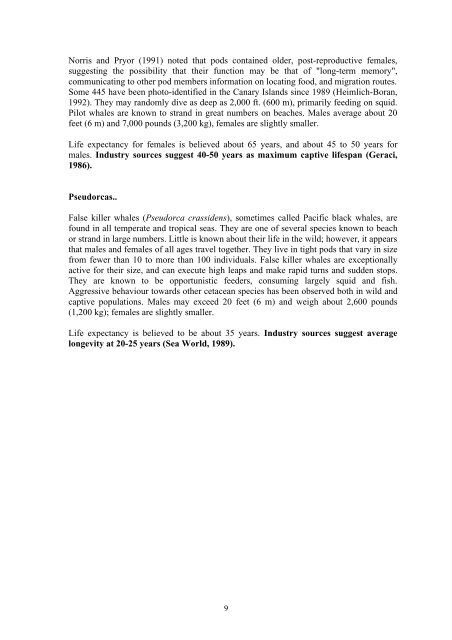Captive Cetaceans: A Handbook for Campaigners - Whale and ...
Captive Cetaceans: A Handbook for Campaigners - Whale and ...
Captive Cetaceans: A Handbook for Campaigners - Whale and ...
Create successful ePaper yourself
Turn your PDF publications into a flip-book with our unique Google optimized e-Paper software.
Norris <strong>and</strong> Pryor (1991) noted that pods contained older, post-reproductive females,<br />
suggesting the possibility that their function may be that of "long-term memory",<br />
communicating to other pod members in<strong>for</strong>mation on locating food, <strong>and</strong> migration routes.<br />
Some 445 have been photo-identified in the Canary Isl<strong>and</strong>s since 1989 (Heimlich-Boran,<br />
1992). They may r<strong>and</strong>omly dive as deep as 2,000 ft. (600 m), primarily feeding on squid.<br />
Pilot whales are known to str<strong>and</strong> in great numbers on beaches. Males average about 20<br />
feet (6 m) <strong>and</strong> 7,000 pounds (3,200 kg), females are slightly smaller.<br />
Life expectancy <strong>for</strong> females is believed about 65 years, <strong>and</strong> about 45 to 50 years <strong>for</strong><br />
males. Industry sources suggest 40-50 years as maximum captive lifespan (Geraci,<br />
1986).<br />
Pseudorcas..<br />
False killer whales (Pseudorca crassidens), sometimes called Pacific black whales, are<br />
found in all temperate <strong>and</strong> tropical seas. They are one of several species known to beach<br />
or str<strong>and</strong> in large numbers. Little is known about their life in the wild; however, it appears<br />
that males <strong>and</strong> females of all ages travel together. They live in tight pods that vary in size<br />
from fewer than 10 to more than 100 individuals. False killer whales are exceptionally<br />
active <strong>for</strong> their size, <strong>and</strong> can execute high leaps <strong>and</strong> make rapid turns <strong>and</strong> sudden stops.<br />
They are known to be opportunistic feeders, consuming largely squid <strong>and</strong> fish.<br />
Aggressive behaviour towards other cetacean species has been observed both in wild <strong>and</strong><br />
captive populations. Males may exceed 20 feet (6 m) <strong>and</strong> weigh about 2,600 pounds<br />
(1,200 kg); females are slightly smaller.<br />
Life expectancy is believed to be about 35 years. Industry sources suggest average<br />
longevity at 20-25 years (Sea World, 1989).<br />
9

















